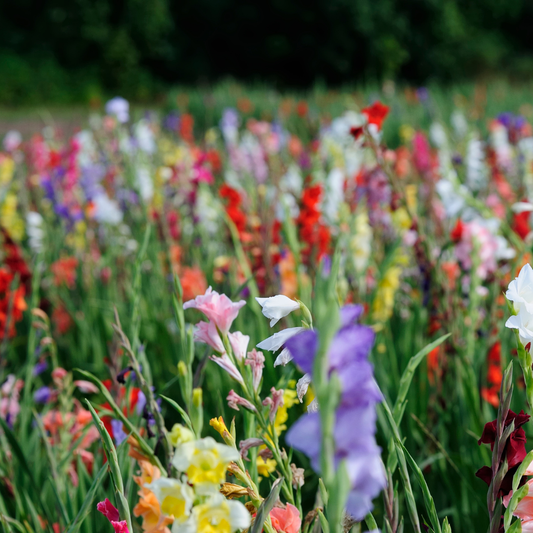
When to Plant Helleborus?
Share
When to Plant Helleborus? Everything You Need to Know
What is Helleborus anyway?
The Helleborus is a true winter hero! This perennial, also known as the Christmas rose, is known for its blooms in the midst of the coldest months. While other plants are hibernating, Helleborus is just coming alive. With its graceful flowers in shades of white, pink, purple, or green, it brings color to your garden when you need it most.
Hellebores aren't just winter bloomers; they're also incredibly hardy. Once planted correctly, they'll thrive for years without much fuss. Whether you're an experienced gardener or just starting out, this plant is perfect for everyone's garden (and heart).
When is the ideal time to plant Helleborus?
The best time to plant hellebores is in autumn or early spring. September through November are ideal months. During this period, the soil is still warm enough for the roots to develop well before winter.
Want to plant later? You can also do so in early spring, from February to April. Make sure it's on a mild, rainy day. This will prevent the plant from drying out when you plant it, and the soil will be nice and moist to welcome the roots.
In open ground or in a greenhouse?
If you're planting Helleborus in the ground, choose a spot with partial to full shade. Ideally, it should be in humus-rich, well-drained soil. Avoid heavy clay soil, or improve it with some perlite or pumice for a more airy structure.
Autumn (September-October) is ideal for a greenhouse, as there's less risk of frost damage. Hellebores often grow a little faster in a heated or unheated greenhouse, but be careful not to let it get too warm.
How to plant a Helleborus step by step
1. Choose a good location
Find a sheltered spot without too much direct sunlight. For example, under a deciduous shrub or tree, so the plant still gets enough light in spring and is protected by its leaves in summer.
Make sure the soil isn't soggy. If your plant is in a location that's too wet, root rot can occur. Add some coconut fiber or hydroponic clay to the planting hole for better drainage.
2. Dig a hole and improve the soil
Dig a hole slightly larger than the Helleborus's root ball. Mix the excavated soil with compost, or use some of our potting soil for Aroids , which is also suitable for perennials with strong roots.
This will give your plant a flying start. Plant the root ball slightly deeper than it was in the pot, as hellebores like deep roots. Fill the hole and press lightly.
3. Water, but in moderation
After planting, give it a generous amount of water immediately, especially during a dry spell or when planting in spring. Later, the Helleborus will hardly need any watering, unless there's been a prolonged rain absence.
Use a handy watering can to water directly, keeping the leaves dry. Wet leaves can lead to mold problems.
4. Maintenance and care
You don't need to prune the Helleborus, but you can cut off old or unsightly leaves in spring. This gives the new flowers plenty of room to shine.
In winter, you can apply some mulch around the plant to protect the roots from frost and keep the soil moist. Consider adding peat moss as an additional layer.
5. Combine plants for extra effect
Helleborus looks beautiful at the edge of a border, among other hardy plants like ornamental grasses, ferns, and groundcover. Want some variety in your garden? Then combine it with plants like Asplenium Parvati , which also thrive in shady conditions.
A ZZ plant or a Dracaena Marginata are also nice choices if you like greenery that requires little care – even indoors!
Frequently asked questions about Helleborus
Can I also plant Helleborus in a pot?
Absolutely! Choose a deep pot with good drainage. If necessary, add a layer of hydroponic clay at the bottom to prevent waterlogging.
Then use an airy but nutritious potting soil, such as our potting soil mix for perennials . Water when the top layer feels dry.
When does Helleborus bloom?
Depending on the variety, Helleborus can bloom from December to April. Helleborus niger is a typical Christmas rose and often blooms around Christmas. Helleborus orientalis blooms a little later, in February-March.
Be sure to prune off spent flowers to encourage new growth. Add some extra compost or fertilizer in the spring to boost next year's blooms.
What if my plant doesn't want to flower?
Don't panic! Sometimes it takes a helleborus a year to establish itself properly. Give it time, remove old leaves, and ensure fertile soil.
Was your Helleborus planted too deep or too wet? Then transplant it to a better location in the fall. Read more about this in our blog post about transplanting .
Is Helleborus poisonous?
Yes, all parts of the Helleborus are poisonous if ingested. So keep dogs, cats, and young children away. Looking for safe indoor alternatives? Then check out our non-toxic plant collection for pets .
Planting hellebores? Get started now!
Planting hellebores is a wonderful way to bring color to your garden during the gray winter months. Whether you plant them in the ground or in a pot, with the right tips, they can provide years of winter blooms.
Combine your Helleborus with other easy-care (and hardy) plants from our perennial collection and create a garden that's vibrant even in winter!
Want some green magic indoors too? Then add easy-care houseplants like the Monstera Minima or the Yucca .
Still have questions about when and how to plant? Then visit our complete collection of when-to-plant blog posts or visit our store in Leuven for personalized advice. We're happy to help.


